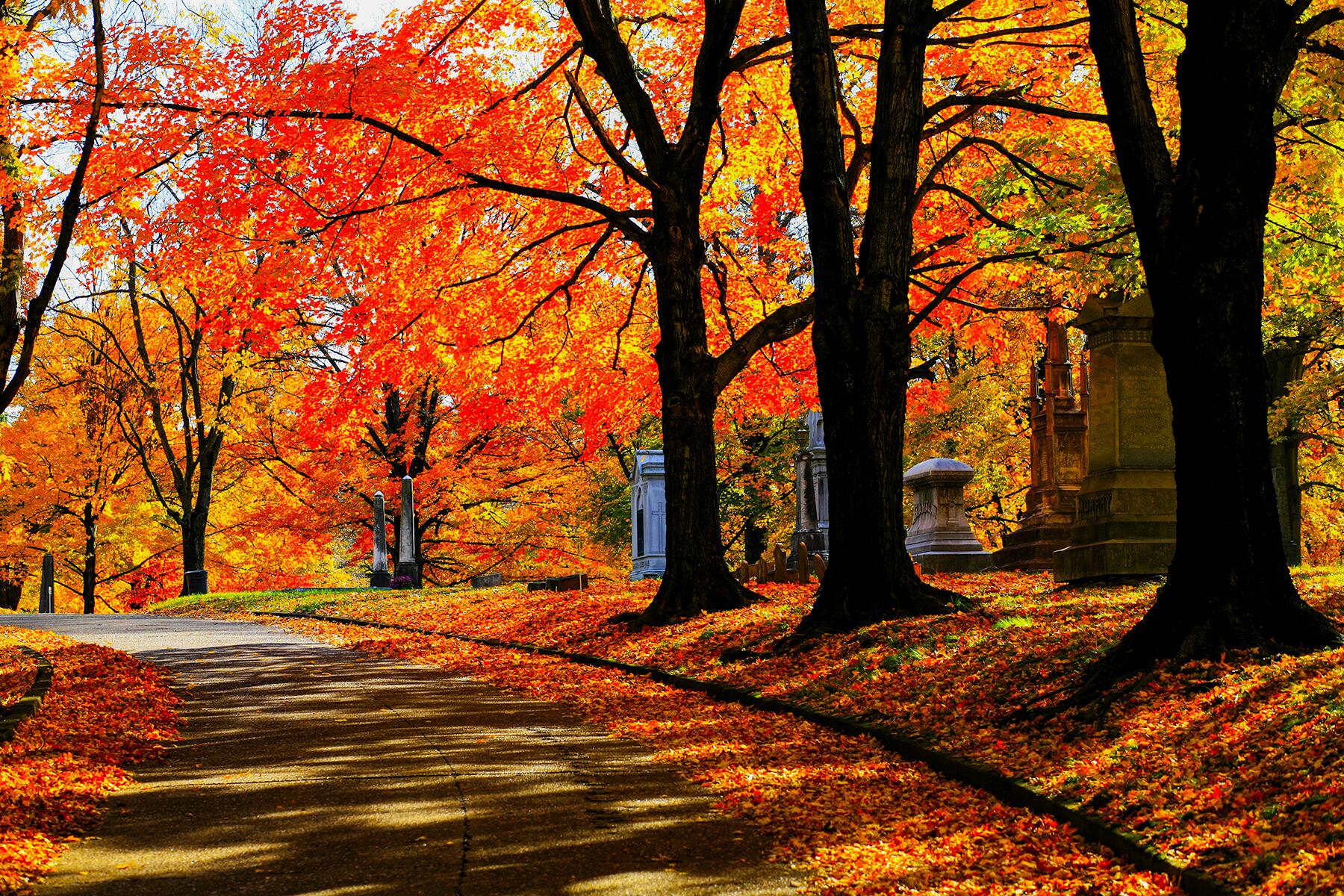
Royal residences in Europe and Asia have inspired writers from Shakespeare, who set Hamlet at Kronborg Castle in Denmark, to Henry James, who admired Switzerland’s lakeside Château de Chillon. In James’s day, wealthy Americans crossed the Atlantic for a grand tour of Europe, visiting the great monuments and castles of the Old World. Today, these opulent palaces are still some of the world’s most popular tourist destinations, offering contemporary visitors a glimpse into the past. You can’t spend a night in these palaces, (though there are many others that have been converted to hotels), but you can visit them and soak in their architectural splendor and rich history. —Laura Itzkowitz

Versailles
Versailles, France
The Château de Versailles was originally built as a hunting lodge, but became the opulent palace celebrated in film and literature under Louis XIV, who moved his entire court from Paris to Versailles. Although peasants stormed it during the French Revolution, visitors today can see how the Sun King and his court lived thanks to extensive restorations. Walk through the Hall of Mirrors, where balls were hosted, the State Apartments, Private Apartments, and the elaborately fashioned grounds with fountains, gardens, and mazes. The Opéra de Versailles, which still performs shows today, is one of the world’s most amazing opera houses. Don’t miss the Hameau de la Reine, a rustic cottage built on the palace grounds where Marie Antoinette used to go to escape the hectic court life and pretend to be a shepherdess.
Insider Tip: A visit to Versailles could be a full day excursion and is easily reachable on the RER from Paris.
PLAN YOUR TRIP: Visit Fodor's Versailles Guide
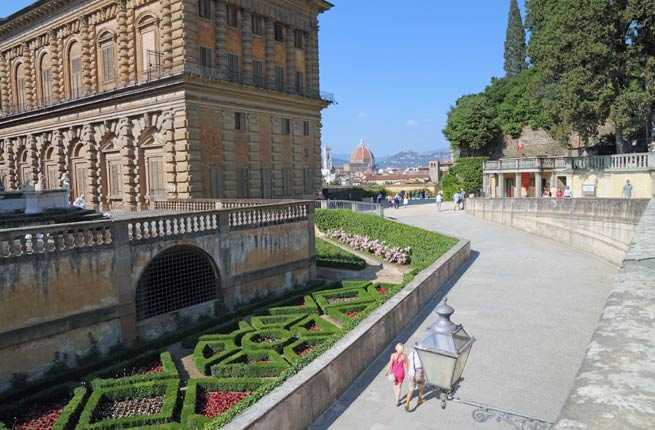
Palazzo Pitti
Florence
The opulent Palazzo Pitti, across the Arno from Florence’s main sights, once housed the dukes of Tuscany and the king of Italy. Acquired by the Medicis in 1549, the family transformed it into a splendid Renaissance palace full of fine furnishings and art. Today, it houses several museums: the Museo degli Argenti, Museo delle Porcellane, Galleria del Costume, and the Galleria d’Arte Moderna. The Galleria Palatina is the most remarkable, with an impressive collection of portraits by Titian and some of Raphael’s most beautiful paintings.
Insider Tip: Be sure to leave enough time to wander the splendid Boboli Gardens. Then, cross the Ponte Vecchio to the Piazza della Signoria.
PLAN YOUR TRIP: Visit Fodor's Florence Guide
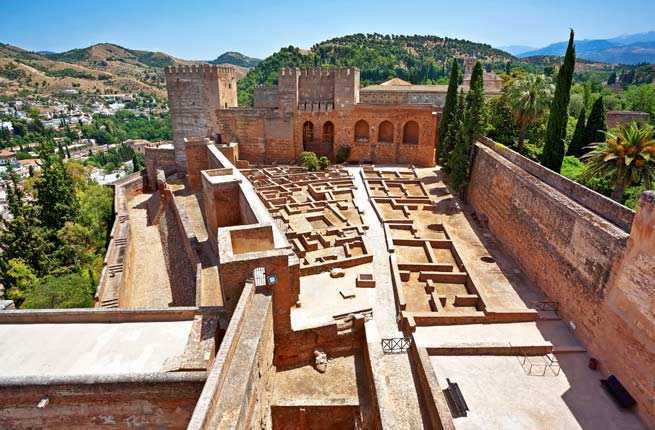
Alhambra
Granada, Spain
Poised high above Granada, on Spain’s Costa del Sol, the Alhambra was built in the 13th century for the kings of the Nasrid Dynasty. With its many courtyards and gardens, the Alhambra stands as an example of Arab influence on the architecture of Southern Spain. All throughout the complex, which includes the Alcazaba fortress, the Nasrid palace, and the Generalife ancient summer palace, carvings feature Arabic writing and motifs. Walk through the impressive palace to the Court of the Lions, which was once the heart of the harem, used only by the king, his wives, and most faithful servants, to admire the intricate carvings and fountains.
Insider Tip: Advance tickets are recommended, as there is a great demand and a limited number of tickets available per day.
PLAN YOUR TRIP: Visit Fodor's Granada Guide

Windsor Castle
Windsor, England
Windsor Castle is the only English castle continuously inhabited by the Royal Family since the Middle Ages and the largest inhabited castle in the world. William the Conqueror chose the site in Berkshire County and began building it in 1070. Over the centuries, it has grown and developed under England’s monarchs, including the Tudors, Charles II, who aimed to rival his cousin Louis XIV’s palace of Versailles, and George IV, who commissioned murals commemorating Napoleon’s defeat at Waterloo. Visitors today can see the magnificent State Apartments, Queen Mary’s Doll’s House, and St. George’s Chapel, where Henry VIII is buried.
Insider Tip: The Changing of the Guard takes place at 11 a.m. on Monday through Saturday from April until the end of July, and on alternating days for the rest of the year. If you want to be sure, check the schedule before you go.
PLAN YOUR TRIP: Visit Fodor's Windsor Guide
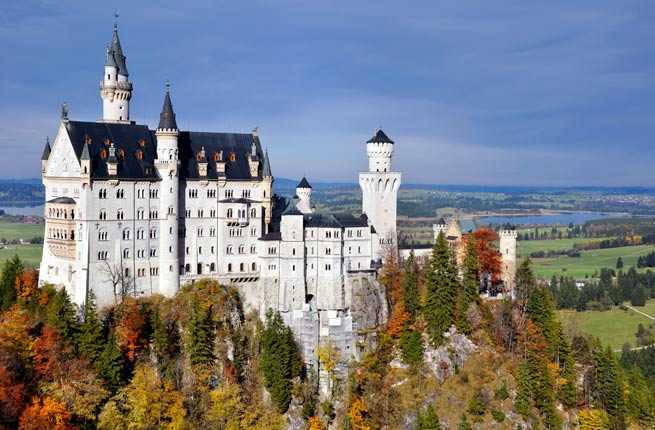
Neuschwanstein Castle
Schwangau, Germany
If Ludwig II’s magnificent Neuschwanstein Castle in Bavaria seems like something out of a fairytale, that’s because it is; Walt Disney modeled the Disneyland castle after it. Sadly, King Ludwig didn’t live to see his precious palace completed. He died before a throne could be installed in his Byzantine-style throne room. Inspired by Wagner’s operas, Ludwig intended to live out his romanticized vision of a reclusive life there, even commissioning set designers to work on the palace to make it more theatrical.
Insider Tip: The castle’s rooms can only be visited on a guided tour. Tickets must be bought in the town of Hohenschwangau below the castle. From the town, visitors can reach the castle by horse-drawn carriage, a short bus ride, or a steep hike.
PLAN YOUR TRIP: Visit Fodor's Hohenschwangau and Neuschwanstein Guide
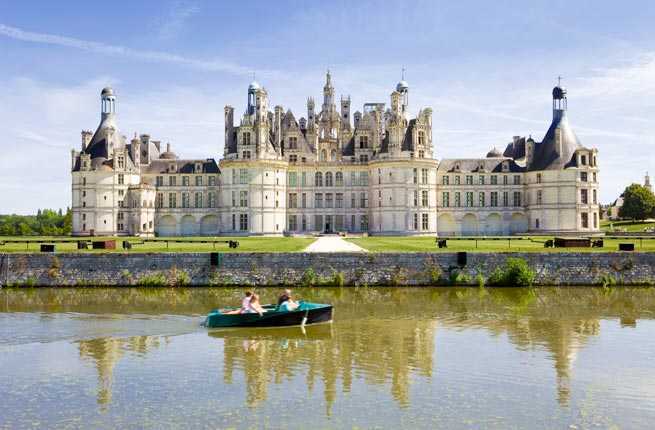
Château de Chambord
Chambord, France
The grandest of France’s Renaissance castles in the Loire Valley, the Château de Chambord was commissioned by François I, though he did not live to see its completion. Leonardo Da Vinci advised the king and may be responsible for the incredible double-helix spiral staircase inside. The enormous castle is a sight to behold, with its many turrets, towers, cupolas, gables, and chimneys. Henry James declared the towers were “more like the spires of a city than the salient points of a single building.” François I only lived there briefly, but built the castle to symbolize his power. The castle is easy to appreciate now, though the original furnishings disappeared during the French Revolution.
Insider Tip: Nearby, you can visit the Château de Chenonceau, the Château de Blois, and other Renaissance castles. The Loire Valley is also known for its excellent wines.
PLAN YOUR TRIP: Visit Fodor's Chambord Guide

Schönbrunn Palace
Vienna
Like a crown jewel set within Vienna’s city limits, the Schönbrunn Palace was the summer residence of the Habsburgs. The palace was commissioned by Emperor Leopold I at the end of the 17th century and modified by Maria Theresa, the only female Habsburg ruler and mother of Marie Antoinette. The stunning baroque structure is characterized by its perfect symmetry, beautiful interiors, and elaborately planned gardens. A six-year-old Mozart performed for Maria Theresa and Marie Antoinette in the Hall of Mirrors, and the Congress of Vienna danced at a ball held in the Great Gallery after parceling out Napoleon’s defeated empire in 1815.
Insider Tip: In the Great Gallery, don’t forget to look up and admire the ceiling mural depicting the prosperous monarchy under Maria Theresa and Francis I.
PLAN YOUR TRIP: Visit Fodor's Vienna Guide
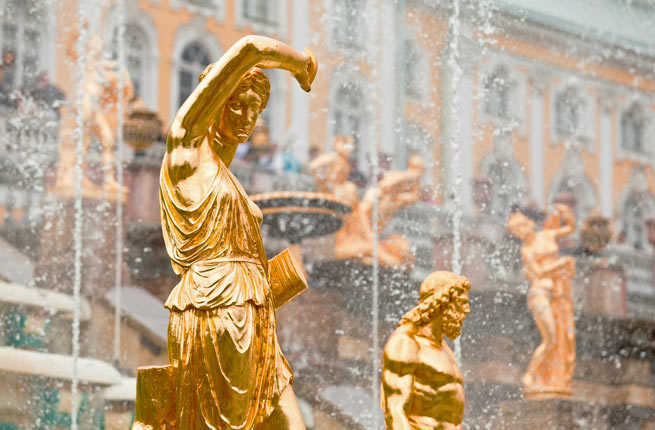
Peterhof Palace
Peterhof, Russia
The ornate Peterhof Palace is sometimes referred to as the “Russian Versailles” and the “capital of fountains.” Peter the Great had the palace complex built as his glorious residence by the sea, though he preferred the modest Monplaisir Palace to the main imperial palace. Though the Peterhof was left in ruins after World War II, it has been carefully restored. Visitors today can wander the Lower Park, where Monplaisir and the Hermitage are located, the Upper Garden with the great Neptune Fountain, the Grand Cascade, and the Main Palace. A visit to the palace is an easy side trip from Saint Petersburg.
Insider Tip: Don’t miss the Chinese Study Rooms decorated with ornate motifs and black lacquer panels.
PLAN YOUR TRIP: Visit Fodor's Peterhof Guide
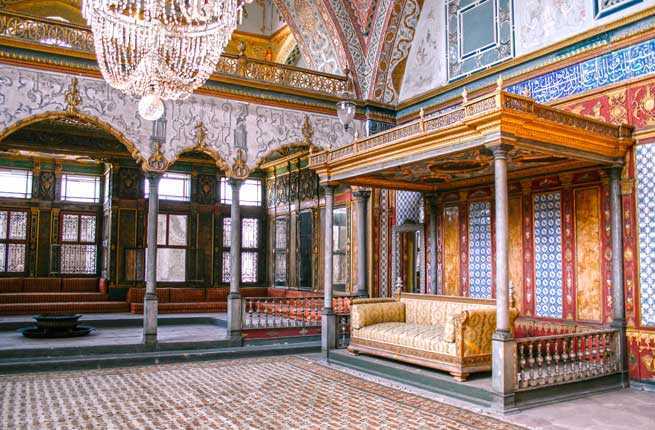
Topkapi Palace
Istanbul
Sultan Mehmed II ordered the construction of the Topkapi Palace above the banks of the Bosphorus after his conquest of Constantinople, and it remained the home of successive sultans and their harems for over 400 years. The enormous palace once housed 5,000 full-time residents, including hundreds of concubines and eunuchs. The First Courtyard, known as the Court of the Janissaries, is freely accessible to the public. A separate ticket must be purchased for access to the harem, which is comprised of 400 halls, terraces, wings, rooms, and apartments that begin modestly and grow larger and more luxurious the farther in you go. The architecture and ornamentation are magnificent, with colorful mosaic tiles, gold Arabic script carved into the walls, and jewels.
Insider Tip: Take a guided tour to learn all about the drama and intrigue that took place within the palace walls.
PLAN YOUR TRIP: Visit Fodor's Istanbul Guide
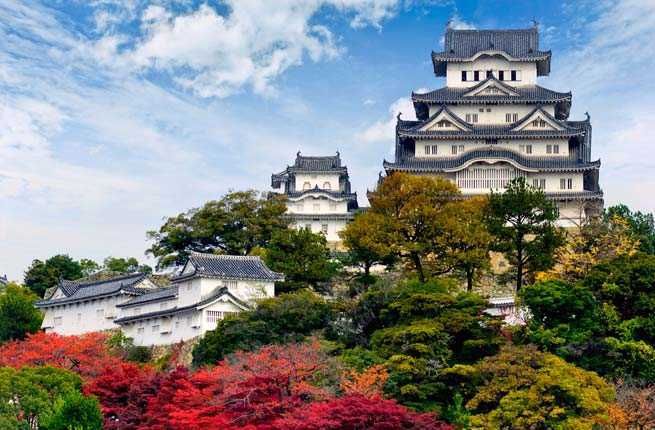
Himeji Palace
Himeji, Japan
Originally built as a fortress, Himeji Castle towers high above the coastal city of Himeji, near Osaka, and the surrounding cherry blossoms. It was constructed as a fortress in 1333 and transformed into a castle in 1346. Later expanded in the early 17th century, it has remained virtually the same ever since, even surviving bombings during World War II. The spectacular wooden palace is protected by three moats and stands five stories high, surrounded by three smaller buildings. It’s easy to get lost in the labyrinth-like grounds, but guided tours in English can help you navigate the spectacular palace.
Insider Tip: Tours can’t be booked in advance, so ask when you buy your ticket. The castle is currently being renovated, and the main building is closed, but the smaller buildings are still accessible.
PLAN YOUR TRIP: Visit Fodor's Kansai Region Guide

Forbidden City
Beijing
With almost 1,000 buildings and a rumored 9,999 rooms, China’s Forbidden City is the world’s largest palace complex. Enter the Forbidden City through the Gate of Heavenly Peace from Tiananmen Square and prepare to feast your eyes on Imperial China’s legacy. Some of the palace complex’s highlights include the Meridian Gate, where the emperor announced planting schedules; the Hall of Supreme Harmony, used for coronations, weddings and royal birthdays; and the Hall of Clocks and Watches. Located in the core of the palace is the imperial throne in the Palace of Heavenly Purity, as well as the empress’s chambers and the room used for her birthday celebrations.
Insider Tip: Be sure to see the Treasure Gallery, full of precious objects, and the Imperial gardens.
PLAN YOUR TRIP: Visit Fodor's Beijing Guide

Grand Palace
Bangkok
One of Thailand’s most popular tourist attractions, the Grand Palace has been the official residence of the kings of Siam since 1782, though the royal family ceased to inhabit it in 1925. The palace is still used for official ceremonies. Though the buildings are closed to the public, visitors are free to wander the grounds and peek inside. The palace complex consists of several buildings, courtyards, gardens, and the Temple of the Emerald Buddha. The Chakri Maha Prasat, built by King Rama V, is a stunning mix of classical Thai architecture and 19th century European styles.
Insider Tip: Beware of local con men, who might try to convince you that you need to buy tickets from them.
PLAN YOUR TRIP: Visit Fodor's Bangkok Guide

Hawa Mahal
Jaipur, India
King Maharaja Sawai Pratap Singh built the Hawa Mahal (Palace of the Winds) in 1799 so the women of the court would have a place to get some fresh air and observe the activity on the street below. The striking pink palace in the heart of Rajasthan, which was once known as “the land of kings,” is made of sandstone and was designed to resemble Krishna’s crown. Every floor has overhanging windows with intricate latticework resembling a honeycomb to let in the westerly winds. Servants used to throw water on the lattices to cool the air.
Insider Tip: Climb to the top of the palace for excellent views of Jaipur seen through the latticed windows. There’s also a small archeological museum inside.
PLAN YOUR TRIP: Visit Fodor's Rajasthan Guide

Palacio Nacional da Pena
Sintra, Portugal
Perched high above the village of Sintra, the Palácio Nacional da Pena was originally the monastery of Nossa Senhora da Pena on the sight of an apparition of the Virgin Mary. The monastery was abandoned in 1834 when the religious orders were suppressed in Portugal, and was left in disrepair. Inspired by German Romanticism, King Ferdinand bought the building and rehabilitated it, turning it into an eclectic castle incorporating Neo-Gothic, Neo-Islamic, and Neo-Renaissance elements. Ferdinand also planted exotic flowers and over 500 species of trees on the grounds. In 1994, the palace was repainted its original colors: pink for the former monastery and ochre for the new palace.
Insider Tip: Sintra is about a 40-minute trip from Lisbon and a mini-train takes visitors from the Park of Pena up to the palace.
PLAN YOUR TRIP: Visit Fodor's Sintra Guide

Eilean Donan Castle
Kyle of Lochalsh, Scotland
Scotland’s most picturesque castle lay in ruins for nearly 200 years—destroyed in a Jacobite uprising in 1719—until Lieutenant Colonel John MacRae-Gilstrap bought the island in 1911 and restored the castle to its former glory. Eilean Donan Castle now stands proudly on an island in the western highlands where three lochs meet. Connected to the mainland by a stone bridge, the romantic castle features high stone walls, wooden ceilings and winding staircases. It has appeared in many movies and TV shows.
Insider Tip: Visitors can access nearly every part of the castle. There’s also a café and gift shop.
PLAN YOUR TRIP: Visit Fodor's Northern Highlands Guide

Blarney Castle
Blarney, Ireland
Famous for the Blarney Stone, which is said to give the “gift of gab” to anyone who kisses it, Blarney Castle is a sight in and of itself. The remains of the castle date back to 1446, though that was actually the castle’s third iteration. As the legend goes, Cormac McCarthy, the king of Munster, assisted Robert the Bruce at the battle of Bannockburn in 1314, prompting Robert to give half of the Stone of Scone (now known as the Blarney Stone) to McCarthy as a gift. The common meaning of the word “blarney” also originates at this castle; intent on taking the castle into her possession, Queen Elizabeth I ordered the Earl of Leicester to negotiate an agreement with McCarthy, who cleverly avoided the conversation by hosting frequent banquets as a form of delay. When the Earl informed the Queen of this impediment, she declared his reports were all “blarney,” though the British never did take control of the castle.
Insider Tip: Long ago, visitors had to be held by the ankles and lowered over the battlements to kiss the Blarney Stone. Today, you simply lie on the parapet walk and lean backwards while holding onto an iron rail.
PLAN YOUR TRIP: Visit Fodor's County Cork Guide
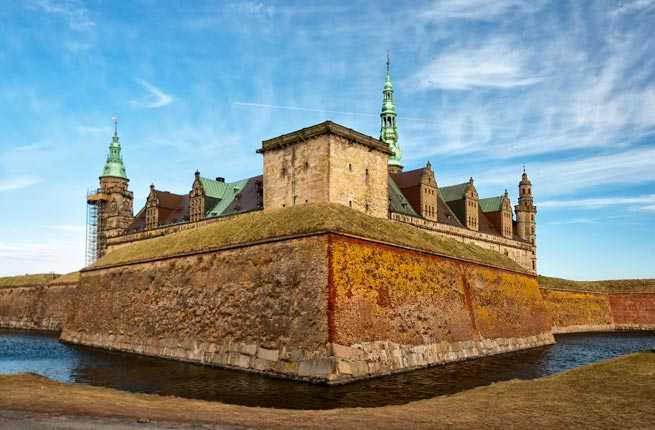
Kronborg Castle
Helsingør, Denmark
Although it is unknown if Shakespeare actually visited Kronborg Castle, the Bard set Hamlet there, forever ensuring its fame. The medieval stronghold was actually built as a tollbooth to collect tariffs from ships crossing the sound between Denmark and Sweden. King Frederik II renovated the castle from 1574 to 1585 and stayed in the royal apartments when he was in Helsingør. The ballroom was the largest royal hall in northern Europe and the gloomy dungeon could accommodate up to 1,000 soldiers. There, a statue of Holger the Dane broods. Legend has it that he will awake from his slumber to protect Denmark from enemy threats.
Insider Tip: You can reach the castle by train from Cophenhagen. Guided tours are available in English.
PLAN YOUR TRIP: Visit Fodor's Denmark Guide
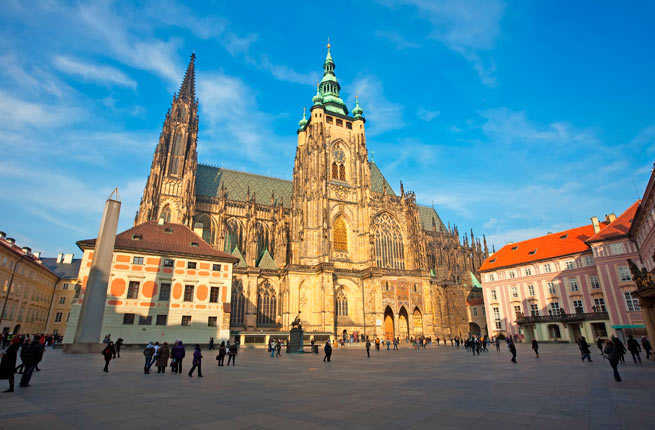
Prague Castle
Prague
Archeological research and the oldest written sources suggest that Prague Castle originated in 880, and it has undergone many changes in the centuries since. The palace complex comprises many buildings linked by internal courtyards. The most important of these are the Starý Královský palác—the royal residence, still the center of political power in the Czech Republic—and St. Vitus Cathedral, which contains the relics of the land’s patron saints. After the fall of communism in 1989, many of the castle’s off-limits areas were reopened to the public. Today, visitors can admire the Royal Garden, the southern garden, the Imperial stables, the royal monuments, and exhibition halls. The Castle is also the site of the infamous Second Defenestration of Prague that launched the Thirty Years’ War in 1618.
Insider Tip: Don’t miss the Prague Castle Picture Gallery, which contains the collection of Emperor Rudolph II and includes paintings by Titian and Rubens.
PLAN YOUR TRIP: Visit Fodor's Prague Guide
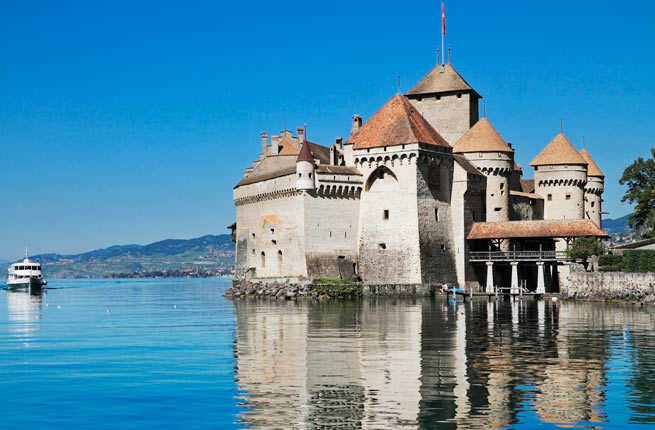
Château de Chillon
Veytaux, Switzerland
Lord Byron was so inspired by the Château de Chillon he carved his name on a pillar in the dungeon and wrote his poem The Prisoner of Chillon about François de Bonivard, the monk who was imprisoned there for supporting the Reformation. He’s not the only one who has found Switzerland’s spectacular lakeside castle inspiring—Henry James set his novella Daisy Miller there, too. The 12th-century castle rises above Lake Geneva at the foot of the Alps amid some stunning scenery. Visitors can see arms and armor, the prison, the crypt, the Duke of Savoy’s quarters, and the grand hall.
Insider Tip: Patience is necessary, as busloads of tourist come to visit the castle in the high season. Relax after your visit with some Clos du Chillon wine from the estate vineyards.
PLAN YOUR TRIP: Visit Fodor's Vaud Guide

Hohenzollern Castle
Tübingen, Germany
The majestic Burg Hohenzollern, perched high on a wooded hill, evokes fairy-tale fantasies. The original castle was completely destroyed and replaced twice: first in 1454 and again in the 1800’s. Crown Prince Frederick William IV of Prussia had the castle rebuilt and filled with opulent furnishings, right down to the doorknobs, some of which are carved to resemble dogs and peacocks. The neo-Gothic architecture, complete with turrets and towers, make the castle a stunning sight. Visitors touring the castle can see the Prussian royal crown and enjoy regional cuisine in the castle’s restaurant.
Insider Tip: In the summer, the beer gardens are open for picnics and sell drinks and snacks.
PLAN YOUR TRIP: Visit Fodor's Heidelberg and the Neckar Valley Guide


